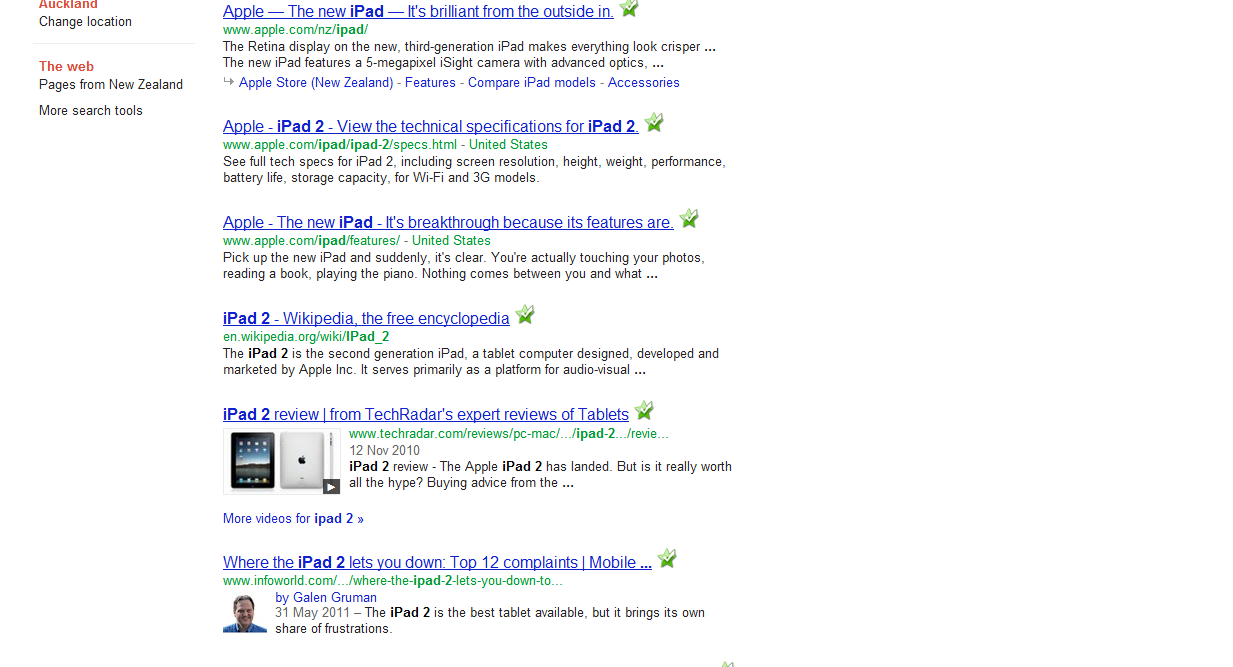Almost a month after the fact, some of the noise has died down, some of the pain has become clear, some of the successes have been celebrated, and a new greater danger has surfaced!
This post describes what I have observed as an SEO consultant based in New Zealand. I have noticed some major impacts to search results while researching keywords for clients – post Penguin.
Please feel free to share this post via the social buttons at the top or with any business that has a website or has paid an SEO provider in the past or is currently doing so.
Wow! Firstly, it has been a hell of a big year for Google so far!
They have clearly signaled their intentions to rid their search results of any spam, any borderline SEO techniques and any “black hat” stuff.
In the last few weeks we have had Blog Networks de-indexed (my post about the massive effects of this one here) and penalities dished out, a free parking bug, two Panda updates in quick succession and to top it all off Google rolled out the nukes on April 24th…
The Penguin Update!
This one has had a remarkable effect on search as we know it. The idea behind it may have been noble but…
Did it work?
What really happened?
What are some of the shocking repercussions of this update?
Google’s Penguin Update was a direct and aggressive assault on the rise of black hat SEO, manipulative search practices, spam, poor quality websites cluttering the top positions in search…
And who would berate them for cleaning up this frustrating and time consuming (and revenue sapping) annoyance? After all, the success of Google relies on delivering the best possible results for any search query.
But, you know what? Penguin was never only about improving search results. It was a more punitive roll-out.
It was about webspam pure and simple!
So, let’s take a look at who won, who lost, who was destroyed and a major new threat to online business.
Maybe we should start with the positive stuff:
The Good:
Ever typed a phrase into Google then been frustrated about the results you are getting?
Yes, the first one is a government site, or Wikipedia, or Amazon… not quite right
Then the next couple are not really what you are looking for…
Then you hit position 4 and BAM! It is a crap site with no relevance to what you are searching for and it is a cheap-ass landing page to get you to click on some lousy banner or to purchase something you don’t want!
And that is a mild version of how spam and black hat SEO pollutes search results.
In a normal day we see a lot of search results and it becomes quite clear at a glance who is breaching Google’s guidelines.
Whenever we create a keyword research project we analyse competition for each keyword to ascertain whether our client is currently able to rank in the top positions for each phrase.
How authoritative is the competition? Do they have good domain authority, page authority, quality links?
It is glaringly obvious when a competitor is breaking the rules.
I have been concerned by a few local SEO providers who have been using what are in my opinion risky, non-compliant practices.
There are a number of dead giveaways which identify who is playing the game and who is not!
What I often see are straight out hacks! Non-compliant time saving short cuts! Sneaky borderline techniques!
The weirdness of search means that often these techniques slip under the radar for a time.
I was surprised to see where an Auckland SEO services provider had evaded detection while using spam techniques of the highest order.
His strategy is simply to build a new website separate to the main client site – use a keyword software tool to spurt out 1,000 related keywords (vaguely related), hit a button to produce a site which has 1,000 duplicated pages with the only variation being an automatically populated Title and Anchor Link…
And then to build authority he hits another button which sends out hundreds of thousands of spam comments across the web…
And to give link variety he hits another program which auto-submits to thousands of low quality, non-moderated directories.
Incredible!
If you are his client you now have every Viagra spammer, every Ponzi scheme, every porn site, every casino and every fake Rolex site linking to yours… Nice!
Up until now his spam sites have been doing surprisingly well. I could follow a number of keywords and find one of the top results was directed to one of these totally bogus sites.
Of course when a searcher got there they were presented with an incomprehensible page of garbage…
But, the clients who engaged this provider would have been given stats around “Hits”, “PageViews”, “Visitors” but NOT conversions or sales!
In fact some of the stats on these pages were mind-boggling – 23,000 visits (according to his site stats) to a page with a keyword that has only 150 searches per month on Google… hello!
OK – I promised the GOOD!
These sites from this particular operator are GONE!
As far as I can tell they are not showing in the first 100 positions of New Zealand Google search results.
And a number of other SEO providers who have used dodgy link farms and blog networks have also evaporated.
Unfortunately, it looks like some of the “respected” main sites connected to these spam sites have taken a hit as well. Without “outing”a company for paying for black hat SEO, one influential company in the local “car rental” niche seems to have hit page 2 and beyond for their main website for what should be their primary industry keyword… Ouch!
You are who you mix with…
Another example is a spammer who left multiple comments on this site. One comment had been published over 400,000 times on the web and gained this suspect operator a top 5 position for a major corporate brand name in the United States…
To sell something completely unrelated…
Yep, these spammers are now gone from Google’s index as well!
Excellent! These are examples of how the Penguin Update has improved search by identifying and destroying webspam.
But, hang on a minute – the story isn’t over yet…
The Bad…
From what I am reading and seeing there seems to be a lot of collateral damage from the Penguin update.
Sure, a lot of businesses who have been tempted to use slightly non-compliant strategies are seeing a dramatic drop in traffic to their websites.
But there also seem to be some businesses who have toed the line and have been punished almost as much as the spammer I have already described.
To be fair it is difficult to separate repercussions from Panda from Blog Network from Panda from Penguin from every other change Google has made… (52 changes in April alone)
And these observations are fairly anecdotal as I have only noticed the trend because of current keyword research projects. (Someone develop software to look at historic search results please).
What I am seeing is that for products which you would expect the big box retailers to rank for, they are surprisingly absent. Try a few FMCG product based searches yourself. You would expect the big retail companies to absolutely dominate these keywords yet they barely feature.
Below is a search in Google New Zealand for iPad 2 (From the start of the organic results). Obviously Apple sites will take the top spots and this is how it should be. Then Wikipedia (not sure a searcher would need a Wikipedia result for iPad)
Interestingly there is not one large retailer on Page one. And only one of the many large New Zealand electronic goods retailers appears on page two – about half way down.
Where are the rest?
This is just iPad 2. Try a search for other consumer goods and see where the big retailers appear.
If the search results do not feature the biggest retailers in New Zealand for many products how could Google think they are offering the best possible results for a given keyword?
I tend to think that this is more about complacency from large brands rather than intentional search engine manipulation penalties.
Their sites suffer from duplication, poor structure, lack of a search strategy…
And they have been able to rely to a degree on a large amount of direct visitors due to their television and print advertising.
And this is where this whole deal gets interesting.
As a major retailer how uncool is it to be penalised in search because you haven’t bothered to implement a comprehensive web strategy?
How much in the way of turnover are you prepared to sacrifice?
Who is monitoring your search traffic?
Now, let’s move away from complacency and look at a company which got hammered by the Penguin Update who had a commitment to creating great content, who had developed a large engaged audience and who had never used an SEO provider in their history.
WPMU went from 8000 daily visitors to less than 1200 overnight (24th April – Penguin).
WPMU are an Australian company that for the most part provide WordPress themes for business. Yes, we all love WordPress and WPMU were one of those companies that made our themes attractive, easy to use, socially functional and all the other great attributes we look for in a site.
And they got SMASHED!
The irony was that they benefited from the Panda Update through their quality content, only to be punished for links that they had very little control over with the roll out of the Penguin Update.
Why were they punished?
We all know the little link in the footer of a website – web design by (web company). Or theme by (WordPress theme creator). Or even SEO by (SEO provider).
I often use this link myself to check out who is responsible for the design of a site – good or bad!
To me it is useful information.
Unfortunately WPMU had these footer links from thousands of websites and this site wide footer link said in most cases “WordPress theme” or some very close anchor text keyword.
And in explanation Matt Cutts from Google identified several spam sites that had used WPMU’s themes.
Damn! That’s a bit harsh don’t you think?
I thought a comment from the CEO was pretty funny. To paraphrase he thought that maybe they should get an SEO to create natural looking links to their site to be Google compliant rather than rely on real natural links.
So, who else got the hit?
Web designers, web developers, SEO, theme creators and anyone else who had a large number of clients with site wide links pointing at their site!
Or SEOs who had followed Google’s advice around using white hat methods to get keyword rich anchor text links to help Google identify what a particular site is about.
But, hang on a minute… isn’t that compliant?
And that is the difficulty in this zone. Google encourages White Hat SEO yet it seems that many times there are white hat casualties from each Update.
Now for the really scary stuff…
The Ugly…
How about this scenario?
Let’s say you are a really sharp black hat SEO and you have made a pile of money by selling your services to businesses with the promise of “the number one spot on Google guaranteed!”.
And to do this you have used techniques I have already described – mass duplication, boiler plate anchor text, comment spam, cloaking, doorway pages and all of the other banned techniques.
Google Penguin arrives!
BAM! No more clients…
They are gone from search, their analytics are showing massive drops in visitors, they are on the phone demanding answers…
So, what should you do now?
The obvious route is to offer your services as a kind of competition “terminator” to clear the search results of a client’s competition.
Simple! “I am in this niche – my site is at position 6 – could you please get rid of the sites in positions 3, 4 and 5. If you do this well then we can look at getting rid of 1 and 2.”
Science fiction?
Unfortunately not!
On the hacker forums there are already credible posts with step by step methods by black hat SEOs who are getting paid to sabotage sites for remuneration.
I am certain this is not the way Google wants things to head but they have opened a can of worms by penalising sites with links from potentially dubious sources.
And some of the outcomes are pretty heartbreaking!
One company which says it has been the target of a negative SEO campaign is offering $10,000 to anyone who can identify which of his competitors paid to have his site sabotaged with massive numbers of poor quality links.
And there is another ugly new threat from this update.
It is becoming apparent that large companies who have taken a hit with the latest updates are examining their link profiles and sending letters threatening legal action if the sites they do not want linking to them do not remove the links.
Wow!
Where is this going to lead?
If every company examined their links and saw that you, with your lowly ranked blog post, linked to them as a reference or for clarification on a point and decided your link “was not worthy” and so demanded you remove it under threat of the heavy legal action that was going to rain down on you….
Then what?
There is an awesome answer to this problem.
And it was covered here on Search Engine Round Table.
Allow us to block links that were uninvited, kind of like blocking spammers on Facebook or blocking robots on Twitter.
We would love to be able to report unsolicited links – we have been hit with a massive number from one site in Brasil which they have not removed after several requests and in the end they have been reported for spam through Webmaster Tools.
That’s it for now…
The cool thing about working in this arena is that there is never stagnation, there is never room for complacency, you never know it all…
What do you think about the Penguin Update?
Successful or not?
Please leave your thoughts in a comment or if you don’t have time to do that (yes we are all time poor) hit the Tweet, Like or share buttons at the top!
Thanks for your time.







